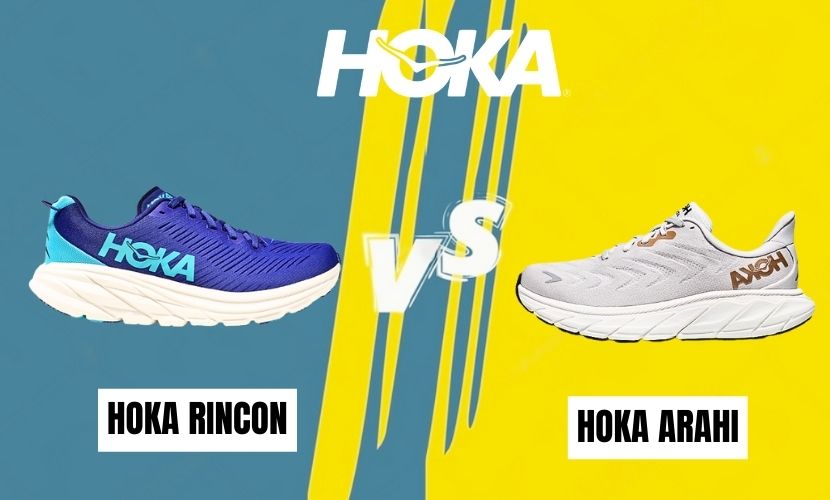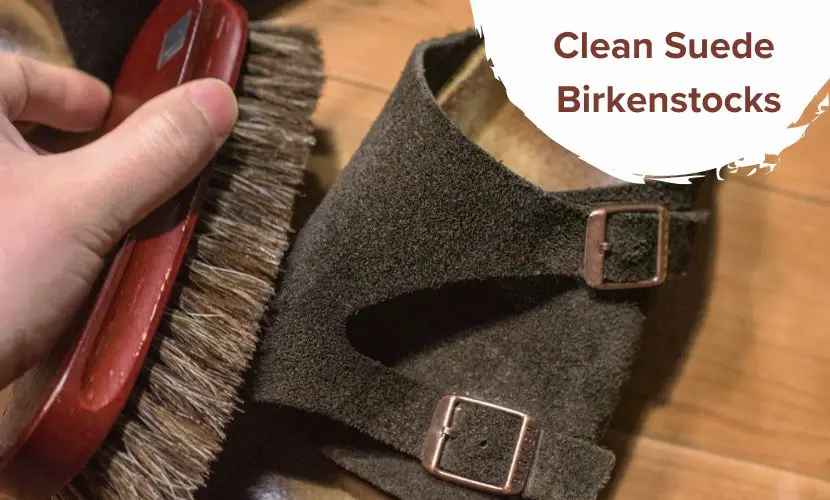Regarding finding the ideal running shoe, it can be stupendous to navigate the wide array of choices accessible. Two famous choices from Hoka One One are the Gaviota and Clifton models. On the other hand, both are structured for road running and have different differences that may affect an athlete’s experience.
The Hoka Gaviota and Clifton models are popular for their padding and support, but several key dissimilarities exist. The Gaviota is structured for moderate to acute overpronators; however, the Clifton is adaptable for neutral runners. Furthermore, the Gaviota is moderately massive and more padded than the Clifton, which may impact an athlete’s speed and legerity. Considering these factors when selecting the two models to verify the perfect fit for your requirements is necessary.
Overall, the Hoka Gaviota and Clifton designs are both outstanding options for road running, but they have distinct differences that may have influenced a runner’s experience. By comprehending the major differences between the two models, athletes can make informed decisions and select the shoe that best matches their requirements.
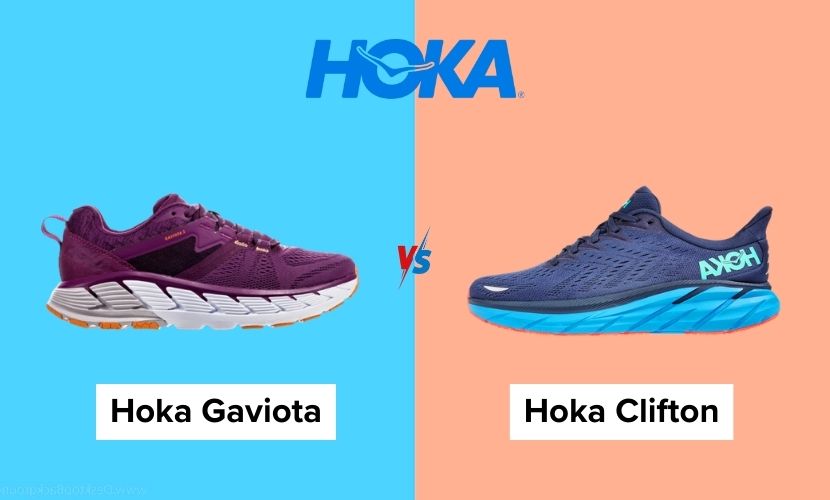
Feature Table: Hoka Gaviota Vs Hoka Clifon
| Aspect | Hoka Gaviota | Hoka Clifton |
| Target Runner | Moderate to severe overpronators | Neutral runners |
| Weight | Moderately heavy | Lightweight |
| Support | Excellent support and stability | Minimal stability |
| Cushioning | High cushioning and responsiveness | Plush and comfortable |
| Upper Material | Engineered mesh and overlays | Seamless mesh |
| Toe Box | Broader toe box | Narrower toe box |
| Heel Lockdown | Organized heel counter | Light and flexible heel counter |
| Ride Feel | Stable and supportive | Soft and responsive |
| Suitable Distances | Long runs, training | Long runs, versatile training |
| Terrain | Road | Road |
| Price Range | Higher end | Mid-range |
Hoka Gaviota: Detailed Overview
Key Features
The Hoka Gaviota is a steady road running shoe from Hoka One One. It is constructed to offer support and padding for athletes who overpronate. The following are several major attributes:
- J-Frame Technology: The Gaviota offers Hoka’s J-Frame technology, which is manufactured to give support and firmness without adding additional weight. The J-Frame is a sturdy density foam that covers around the heel and elongates through the midfoot for extra support.
- RMAT Midsole: The Gaviota’s midsole is designed of Hoka’s proprietary RMAT material, constructed to give cushioning and reactiveness. The RMAT material is also hard-wearing and resistant to compression, which shows it will adjust its appearance and padding over time.
- Arch-Lock Wings: The Gaviota contains Arch-Lock wings on the sides of the shoe, which are constructed to offer a safe and supportive fit around the midfoot. The wings cover the foot and can be maintained for a personalised fit.
Pros
- The Gaviota offers excellent aid and stability for athletes who overpronate.
- The J-Frame technology and Arch-Lock wings give a safe and snug fit.
- The RMAT midsole features padding and responsiveness without contributing additional weight.
Cons
- The Gaviota is more heavier than several other running shoes in the industry, which may be an issue for several athletes.
- Some players may discover the Arch-Lock wings to be too narrow or uncomfortable.
- The Gaviota is a bit costly contrasted to other running shoes in its class.
Hoka Clifton: Detailed Overview
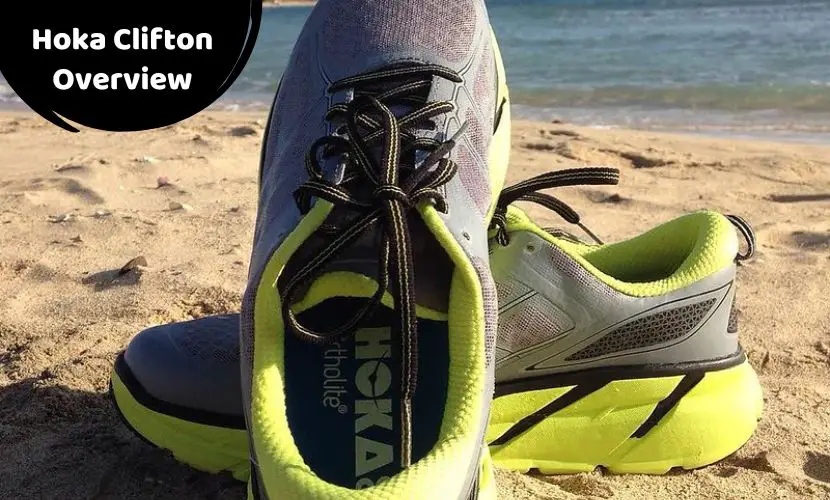
Key Features
The Hoka Clifton is a famous road running shoe constructed for runners searching for a comfortable, feathery shoe that can handle elongated runs and regular training. The following are several major attributes of the shoe:
- Meta-Rocker technique for an even ride
- Delicate and permeable mesh upper
- Early-stage Meta-Rocker for a plane and reactive ride
- Whole-compression EVA midsole for padding and support
- 5mm heel-to-toe drop for an innate feel
- Rubber outsole for longevity and traction
Pros and Cons
Like any shoe, the Hoka Clifton has its advantages and disadvantages. The following are several things to examine:
Pros
- Lightweight, snug, and permeable
- Provides adequate padding for long runs
- Reactive and even ride thanks to Meta-Rocker technology
- Hard-wearing enough for regular training
Cons
- It may not offer enough aid for athletes with overpronation
- Some athletes may discover the shoe too narrow
- The padding may feel too mushy for some athletes prioritising a firmer ride.
Overall, the Hoka Clifton is an amazing shoe for players searching for a snug and feathery shoe that can control long runs and routine training. Its Meta-Rocker technology offers a smooth and reactive ride, while its whole-compression EVA midsole gives sufficient padding and support. However, athletes with overpronation may require a shoe with more support, and those who prioritise a sturdy ride may find the padding too mushy.
Material Comparison
Concerning selecting between the Hoka Gaviota and Clifton, one of the most efficient factors to examine is the materials utilised in their construction. In this part, we will contrast the components used in both shoes’ insole, midsole, outsole, and upper.
Insole
The insole of the Hoka Gaviota is structured with OrthoLite foam, which offers padding and support. Conversely, the Clifton features an EVA foam insole that offers comfort and aid. Both insoles are portable, making it easy to restore with traditional orthotics if required.
Midsole
The midsole is where the bulk of the padding and support is available in both shoes. The Gaviota provides Hoka’s J-Frame technology, which is constructed to offer stability and aid for overpronators. Conversely, Clifton provides Hoka’s Meta-Rocker technology, engineered to encourage a smooth and efficient pace.
In the case of materials, both shoes offer a compression-moulded EVA midsole. However, the Gaviota contains a more massive midsole than the Clifton, which offers more aid and stability.
Outsole
The outsole of both shoes is manufactured of rubber and provides a strategic design of grooves and lugs to offer grip and durability. The Gaviota contains a broader base than the Clifton, which offers more steadiness and support. However, Clifton’s outsole is moderately more flexible, allowing for a more natural foot motion.
Upper
The upper of the Gaviota is designed of an amalgamation of engineered netting and fabricated overlays, which give a safe and snug fit. The Clifton’s upper is engineered of a similar manufactured mesh but provides fewer overlays for a more feathery and permeable feel.
Both shoes offer a cushioned tongue and collar for additional comfort and a customary lace-up closure for a personalised fit.
Overall, the Hoka Gaviota and Clifton provide top-quality, structured materials that provide comfort, aid, and durability. The selection between the two will eventually depend on individual needs and particular requirements, such as stability or stretchability.
Comparing Hoka Gaviota and Clifton
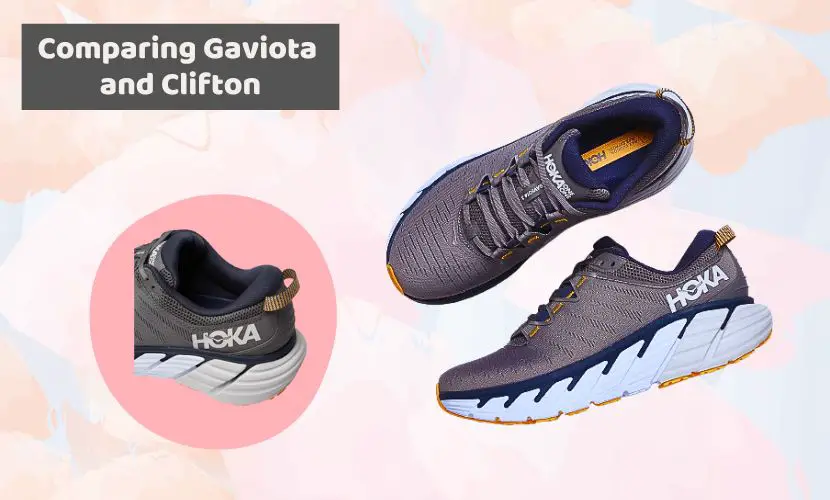
Comfort and Fit
Both Hoka Gaviota and Clifton are constructed to offer runners additional comfort and support throughout their runs. The Gaviota inclines to have a broader toe box contrasted to the Clifton, permitting more space for toe splay, accommodating athletes with extensive feet or those who prioritise a more roomy fit. The additional width in the toe box gives a snug and natural feel, lessening any potential discomfort or stress points.
Conversely, the Clifton has a tighter toe box, which may be more adaptable for athletes with narrower feet. However, Clifton’s upper is designed of a permeable netting material that adapts to the foot, giving a snug and cosy fit. The Clifton cushioning is also different, providing a feathery, mushy step-in feel that doesn’t stay compressed.
Overall, both shoes provide great ease and support, but the Gaviota may be a finer option for athletes with broader feet or those who prioritise a more roomy fit; on the contrary, the Clifton may be a superior option for athletes with tighter feet who prioritise a comfortable fit.
Durability
Regarding durability, both the Gaviota and Clifton are constructed to resist the deterioration of daily running. The Gaviota contains a durable rubber outsole that gives remarkable traction and withstands abrasion; on the contrary, the Clifton has a fortified toe cap that shields the shoe from erosion.
However, some athletes have mentioned that the Gaviota’s upper may deteriorate faster than the Clifton’s, specifically in the toe box area. This may be because of the Gaviota’s broader toe box, leading to more friction and rubbing against the upper.
Overall, both shoes are hard-wearing and can resist regular running, but the Clifton may contain a moderate advantage in the case of upper durability.
In summary, both Hoka Gaviota and Clifton are remarkable running shoes with great ease and support. The Gaviota may be a finer choice for runners with broader feet or those prioritising a more roomy fit. At the same time, the Clifton may be a finer option for athletes with tighter feet who prioritise a comfortable fit. Both shoes are long-lasting and can resist daily running, but the Clifton may have an average advantage in upper durability.
Price
There is a detectable difference between Hoka Gaviota and Clifton costs. The Gaviota is typically more costly than the Clifton, which may be a factor for several athletes when creating their decision.
The current costs for these shoes on Amazon are given below:
- Hoka Gaviota Men’s: $149.95
- Hoka Gaviota Women’s: $149.95
- Hoka Clifton Men’s: $129.95
- Hoka Clifton Women’s: $129.95
It is necessary to mention that prices may differ based on the retailer, and sales or discounts may be accessible at certain times.
On the other hand, the Gaviota is more costly, but it does provide extraordinary attributes such as a stability pattern and a more hard-wearing outsole. However, the Clifton still gives a snug and delicate ride at a more economical price.
What are the key differences between Hoka Gaviota and Clifton?
Hoka Gaviota and Clifton are two famous road running shoes from Hoka One One. On the other hand, both shoes have some similarities but contain several major dissimilarities that separate them.
Upper Construction and Materials
The upper formation and materials of the Hoka Gaviota and Clifton are distinct. The Gaviota has a more constructed upper that gives more support and steadiness, while the Clifton contains a more unembellished, delicate, and absorbent upper. The Gaviota also contains a bulkier tongue and cushioning around the collar for extra comfort.
Toe Box Width and Roominess
The toe box width and roominess of the Hoka Gaviota and Clifton are also distinct. The Gaviota contains a broader toe box that offers more space for the toes to splay; on the contrary, the Clifton contains a tight toe box that gives a more comfortable fit. The Gaviota may be a finer option if you have extensive feet or prioritise a roomier fit.
Heel and Midfoot Lockdown
The heel and midfoot lockdown of the Hoka Gaviota and Clifton are alike. Both shoes contain a safe fit around the heel and midfoot, which aids in averting slipping and sliding inside the shoe. However, the Gaviota contains a more organised heel counter that gives more aid and firmness, while the Clifton has a more unembellished heel counter that is feathery and more flexible.
Overall, the Hoka Gaviota and Clifton are both remarkable road running shoes. Still, they have several major differences that may create one shoe a finer option for you than the other.
Which shoe is better for long-distance running, Hoka Gaviota or Clifton?
Regarding long-distance running, both Hoka Gaviota and Clifton are amazing choices, but several differences might create one a finer choice for several runners.
The Hoka Gaviota is a steady shoe providing high padding and support standards. It is structured to help minimise overpronation and offer a stable ride. The shoe has a broad base, which aids with firmness, and a rocker pattern that encourages an even transition from heel to toe. The upper is designed of a permeable netting material that offers a snug and safe fit.
On the other side, the Hoka Clifton is a moderate shoe that also provides a high standard of cushioning. It is structured to be feathery and reactive, creating it an ideal option for runners who desire a fast and snug ride. The shoe has a moderately narrower base than the Gaviota, which permits a more natural foot strike. The upper is constructed of a seamless netting material that gives a snug and permeable fit.
Concerning long-distance running, the Hoka Gaviota might be a finer option for athletes who need additional steadiness and support. The extensive base and rocker pattern helps lessen overpronation and gives a stable ride, particularly during long runs. Conversely, the Clifton might be a superior option for runners who desire a delicate, reactive shoe that can control long distances. The moderately tighter base permits a more natural foot strike, supporting minimising tiredness and upgrading overall performance.
Both shoes provide a high level of cushioning and ease, but the Gaviota gives additional firmness and support; on the contrary, the Clifton is structured for speed and reactiveness. Runners should test both shoes and detect which feels finer for their feet and running style.
What type of runner would benefit most from Hoka Clifton shoes?
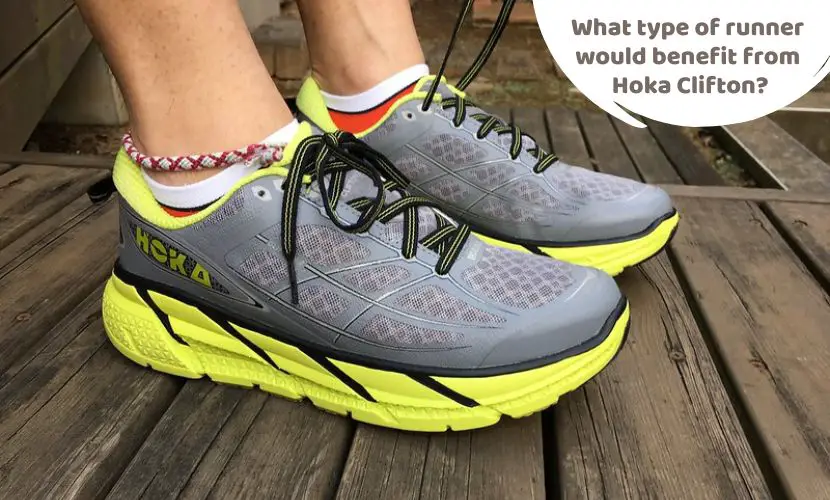
Hoka Clifton shoes are perfect for athletes who prefer comfort and padding. They are structured for neutral athletes searching for a regular trainer to control various workouts, from cosy recovery runs to elongated-distance races.
The Hoka Clifton shoes are specifically adaptable for runners who:
- Prefer a soft and plush ride: The Clifton’s midsole is designed of EVA foam, giving great padding and comfort. This creates the shoe perfect for runners who desire to shield their joints and minimise the effect of running on their bodies.
- Need a versatile shoe: The Hoka Clifton shoes are adaptable for many workouts, from easy recovery runs to long-distance races. They are also ideal for athletes who need similar road and treadmill running shoes.
- Want a secure and comfortable fit: The Hoka Clifton shoes contain an upper structure to offer a safe and snug fit. The upper is designed of a porous mesh material that adapts to the foot’s appearance, giving a comfortable fit without feeling too narrow.
- Prefer a lightweight shoe: While the Hoka Clifton shoes are not the delicate shoes in the industry, they are still comparatively feathery contrasted to other shoes in their category. This makes them a perfect option for athletes who desire snug and lightweight shoes.
Overall, the Hoka Clifton shoes are an amazing option for runners who prefer comfort, padding, and versatility. They are adaptable for many workouts and are structured to offer a safe and snug fit.
What is the weight difference between Hoka Gaviota and Clifton?
Regarding running shoes, weight is an efficient factor to consider. The feathery the shoe, the less energy you will use to elevate your feet, which can help upgrade your running performance. So, what is the weight difference between Hoka Gaviota and Clifton?
According to our findings, the Hoka Gaviota weighs approximately 10.7 ounces for men and 9.0 ounces for women; on the other hand, the Hoka Clifton weighs around 8.7 ounces for men and 7.4 ounces for women. This shows that Clifton is notably lighter than the Gaviota.
However, it’s necessary to mention that weight is not the only factor to examine when selecting a running shoe. The Gaviota provides more support and steadiness than the Clifton, which may be advantageous for athletes who overpronate or require more cushioning.
If you prefer feathery shoes and don’t need as much aid, the Clifton may be your finer choice. However, the Gaviota may be the way to go if you require more steadiness and padding.
Can You Use Hoka Gaviota or Clifton Shoes for Trail Running?
Hoka Gaviota and Clifton shoes are both structured for road running. However, several athletes may wonder if they can also utilise them for trail running.
While both shoes provide excellent padding and support, there may be better choices for trail running. Trail running shoes are structured with particular attributes to control the challenges of off-road terrain, just like rocks, roots, and uneven surfaces.
The following are several reasons why the Hoka Gaviota and Clifton shoes may not be the perfect option for trail running:
- Traction: The outsole of road running shoes is structured for even surfaces and may need to offer more grip on slippery or loose terrain. Trail running shoes contain a more aggressive tread design to offer finer traction on uneven surfaces.
- Durability: Trail running shoes are constructed to resist the deterioration of rough terrain. Road running shoes may not sustain well on trails and may collapse faster.
- Protection: Trail running shoes frequently have extra attributes such as rock plates to shield the feet from edgy rocks and debris. Road running shoes may not give adequate protection for trail running.
While utilising Hoka Gaviota or Clifton shoes for trail running is feasible, it is not suggested. For perfect performance and safety, spending on a pair of trail running shoes structured particularly for off-road terrain is ideal.
Conclusion
The Hoka Gaviota is a sturdy shoe; on the contrary, the Hoka Clifton is a moderate shoe. The Gaviota may be the finer choice if you require more aid and correction for overpronation.
The Gaviota is massive and more structured; conversely, the Clifton is feathery and more flexible. The Gaviota may be superior if you prefer padding and comfort over speed and legerity.
Both shoes provide remarkable padding, durability, and a snug fit. Testing and detecting which feels finer for your foot appearance and running style is suggested.
In conclusion, the Hoka Gaviota and Hoka Clifton have advantages and disadvantages. It’s necessary to consider your particular requirements and likings when selecting which shoe to buy.
Read more on:

